GODZILLA VS KONG... AND THE REST OF THE MONSTERVERSE
Directed by Adam Wingard. 2021. United States.
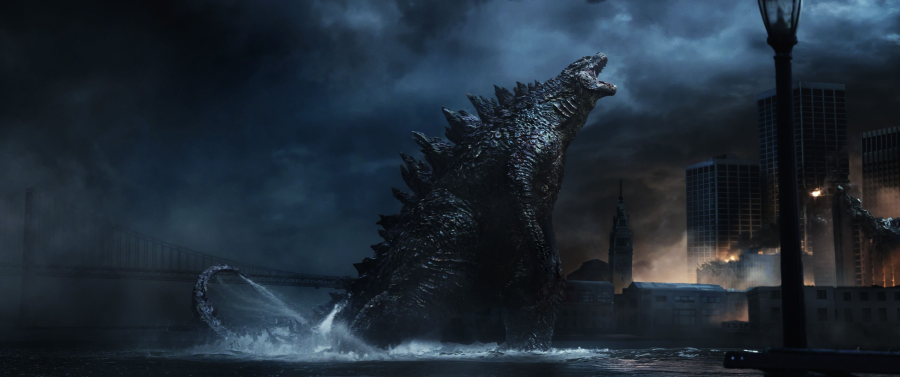
Now that the Warner Bros. and Legendary MonsterVerse has ostensibly come to a close, we can look back with some degree of impartiality on how it all played out. As a lifelong fan of Godzilla and his monstrous adversaries since childhood, I was extremely excited for Gareth Edwards’s 2014 American adaptation. And I say “adaptation” because that is precisely what the first trailers led us to believe it would be, a call back to the 1954 original GOJIRA with its radioactive beast destroying everything in his path. We got the requisite vistas of destroyed cities with Oppenheimer quotes playing over top of them. “Now am I become Death, the destroyer of worlds”.
But the trailers were a kind of bait and switch. Godzilla wouldn’t be the embodiment of nuclear terror found in the Ishiro Honda original. He would be Godzilla, the protector of worlds, a slumbering beast reawakened to combat the real threat, a pair of insectoid kaiju called the MUTO. While there would be some hint of social and political commentary regarding the use of nuclear weapons, their proliferation, the generational guilt over how WWII ended, etc., most of this would be briefly mentioned and then let go into the wind.
GODZILLA 2014
Gareth Edwards’s GODZILLA would be much more about the realistic - at least as realistic as any of this could be - depiction of what a giant monster attack would look like. It’s a film concerned primarily with the visceral, not the intellectual. As a result, we see every single shot from the point of view, spatial or otherwise, of a human being. It’s a movie in love with the grandiose size of its threats, littered with characters gazing skyward in shocked disbelief at the sheer enormity of everything going on around them. The humans of the story are the main characters here, not the monsters.
As such, we rarely see the monsters fight, a major point of contention with the film’s audience. There’s a moment near the beginning of the third act where we follow Elizabeth Olsen’s Elle as she helps load up evacuees in an ambulance. She wanders into a quickly emptying street only to see the winged MUTO land atop a skyscraper. She runs down the street in fear (as anyone would) only to be stopped dead in her tracks by the sight of Godzilla rising out of the ocean. Sandwiched between two titans, she can do nothing but run for relative safety into a nearby subway tunnel. The last thing she sees before the doors swing shut is the MUTO flying straight at Godzilla. We cut away. The fight isn’t important. It’s the mere sight of two massive creatures colliding that’s important.
When we next see the city, it’s from the point of view of Elle’s military man husband, Ford, as he parachutes in. Again, there’s a fight going on but it’s not what we focus on. The camera is showing us Ford’s literal point of view, his eyes scanning the sheer devastation that these beasts have caused in just a couple of hours. Seeing the mushroom cloud is one thing. Seeing the devastation it leaves in its wake is another thing entirely.
We do finally get to engage in a short bout of monster-on-monster-on-monster chaos as Godzilla does what Godzilla does best. He emerges victorious at the close of the film and news reports hail him as “the king of the monsters” and “our savior”. Godzilla waddles back into the ocean and disappears, leaving behind him a completely ruined San Francisco and untold numbers of people dead in the rubble. This is where the film leaves us, with the strange sort of moral question that superhero movies, in particular, struggled with until CAPTAIN AMERICA: CIVIL WAR came along. When the heroes cause as much death and destruction as the villains, what exactly does it mean to be a hero?
Because that’s never what Godzilla was, even when he wasn’t purposefully destroying every pagoda he could lay his scaly hands on. The shark in JAWS isn’t a villain. It’s just a shark doing what sharks do. Godzilla was never intentionally saving mankind when he fought Ebirah or Hedorah. He was simply protecting what he felt was his turf. We were merely the beneficiaries of those conquests. The Toho films, especially the Showa period of Godzilla films which ran from 1954 to 1975, often used the old sci-fi trope of invading aliens as a method of working in a human story. In those films, the aliens possessed a weapon capable of decimating Earth. It just so happened to be a giant monster instead of a giant space laser. The fact that the human struggle against the aliens coincided with Godzilla’s fights against the opposing giant monster was more or less a happy coincidence. Godzilla became a hero primarily because well… he kinda did us a favor without knowing it.
There are moments in most of these MonsterVerse films where Godzilla quizzically looks at a human being. He doesn’t openly show aggression towards them but why would he? An ant inside my house is no threat to me. But a few hundred ants inside my home? What about a few hundred ants all shooting ballistic missiles at me while I just go about my day-to-day? Yeah, I’d bring out the bug spray too.
KONG: SKULL ISLAND
Essentially a prequel to the entire MonsterVerse, Jordan Vogt-Roberts’s KONG: SKULL ISLAND gives us a kind of origin point for Monarch, a super-secret government agency whose job is to track and study giant monsters. When we first meet Bill Randa, the head of Monarch, he’s regarded as nothing more than a cryptozoologist. News of Godzilla, who we learned in the first film was awoken by nuclear tests during the 1950s, is already known by the military. That would seem to me to be enough to validate Randa’s theories about monsters existing but alas…
Randa conscripts a cadre of recently decommissioned Vietnam vets to fly to the mysterious Skull Island to study the environment. They’re met by Kong, a gigantic adolescent ape, who quickly dispatches most of the military. What follows is little more than a retread of the original KING KONG, minus the whole “bring the ape back to the mainland” storyline. Here, the goal - at least to the military - is the destruction, not the exploitation, of Kong.
Right from the start, KONG: SKULL ISLAND seems designed to answer the criticisms levied at GODZILLA 2014. Audiences complained about the short on-screen time of its titular creature so Vogt-Roberts gives us quite a bit of Kong. We see him fight other monsters, rescue a giant ox, eat a squid, fight more monsters, all kinds of stuff. GODZILLA 2014 was criticized for being too dark, not in tone but presentation. So here we see most of the action during the daytime hours. The characters in Edwards’s film were roundly decried as being flat and lifeless, so here we get a cast full of action movie stereotypes and comic relief.
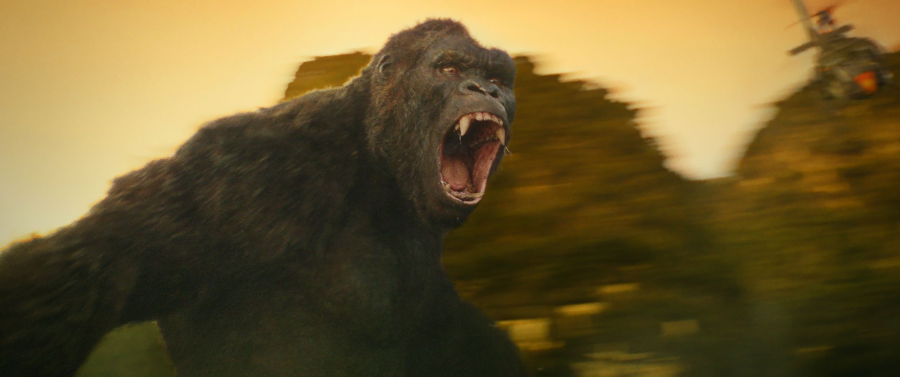
It’s a lighter tone despite being just as heavy a movie as its predecessor. Kong is explicitly more heroic, more human in his motivations, than Godzilla. He’s treated heroically, given plenty of action movie scenes meant to get the audiences roaring. But there’s an undercurrent of almost existential angst lying underneath all the theatrics. Samuel L. Jackson’s Preston Packard is the embodiment of American military domination. The “war” the soldiers find themselves in on Skull Island seems every bit as unfair and unnecessary as the war they just left. The fact that most of them die particularly cruel deaths is the bitter icing on that cake. Kong himself is painted as a lonely and almost pathetic creature, aimlessly wandering a world without family or kin, the last of his kind, conscripted into his own kind of war against the skullcrawlers, subterranean beasts who threaten every living thing on the island.
KONG: SKULL ISLAND gives us the hero monster GODZILLA 2014 only purported to give us. Godzilla drowns thousands just by making landfall in Hawaii and couldn’t care less. Kong puts himself in danger to rescue a drowning Brie Larson. He regards humanity not as equals but as something worth protecting. Whether that’s instinctual, done out of boredom, or whatever… The fact of the matter is, Kong is a character, not merely a force of nature and Vogt-Roberts goes out of his way to accentuate that during the film.
The lessons learned by the characters in KONG: SKULL ISLAND bleed over into the next film in the franchise. Giant monsters exist. They’re part of the natural world. We need to co-exist with them because dominating them isn’t within our power. But what if co-existence isn't an option?
GODZILLA: KING OF THE MONSTERS
With the audience response to the changes in tone and presentation between the last two films largely positive, work on a follow-up went underway. Designed as a kind of love letter to the Toho films of the 1960s, GODZILLA: KING OF MONSTERS would give us a full-scale monster fest, bringing in fan-favorite monsters like Rodan, Mothra, and King Ghidorah. Director Michael Dougherty’s approach to all of this is pure comic book movie. Each monster receives its own color pattern (red for Rodan, yellow for Ghidorah, green for Mothra, and blue for Godzilla) and moments of hero posing for the camera. The action is ridiculously over the top with the camera zipping in and out of the action to always give us the best possible shot of whatever impossible thing is currently underway.
If this isn’t enough to tell you that realism has gone straight out the window, we’re given a scene of scientists and military types discussing why the superweapon that critically wounded Godzilla didn’t also critically wound the three-headed Ghidorah. Someone casually mentions that the reason is because Ghidorah isn’t from Earth. It’s an alien species. Everyone nods and moves right along. At no point does anyone in the room say
“Whoa whoa whoa… can we back up a minute?”
Of course, underlying all of this nonsense is something very serious. We’re given two opposing factions, one spearheaded by Monarch and the other by a group of eco-terrorists. Human activity has spoiled the world, draining it of resources. The eco-terrorists are planning on releasing all of the slumbering titans using a device called the Orca, a machine capable of rudimentary communication with monsters. Once unleashed, the beasts will obliterate centuries of human intervention and destruction, their latent radioactive abilities reinvigorating the Earth. Of course, that means the near-total destruction of the human race but hey… Can’t make an omelet, right?
Unfortunately, one of those monsters just happens to be the aforementioned space alien Ghidorah, a mighty monster whose sole existence revolves around destruction, not rebirth. As the clear alpha titan of the bunch, the other monsters (the film tells us there are 17 of these titans all around the globe) follow suit, wrecking shit left, right and center. It’s up to the Monarch scientists to bring Godzilla back from near death so he can end Ghidorah’s short reign of terror before it escalates to full-on extinction.
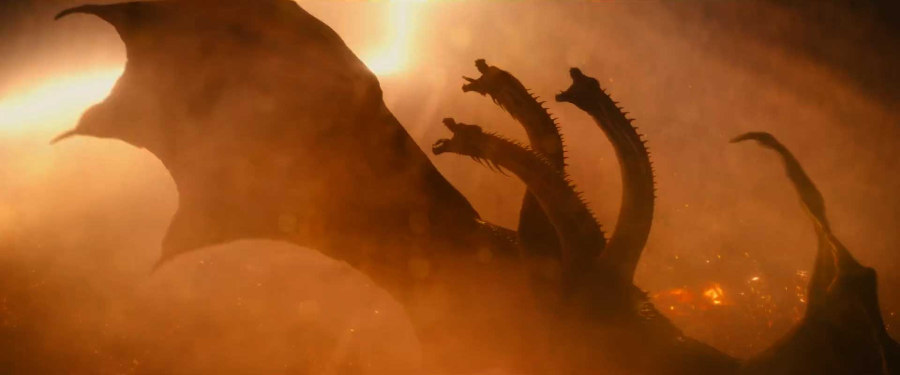
Now, I love this movie. I really do. It is everything I could have hoped for in a Hollywood Godzilla movie. It is littered with music cues taken from Akira Ifukube’s classic Toho scores. Each of the monsters is faithfully adapted here and the visual effects give them clear and distinct personalities that perfectly match their Toho counterparts. Visually, it is arresting, downright gorgeous at all times, and the fights are breathtaking in scope and audacity.
But those changes brought in from KONG: SKULL ISLAND are ratcheted up to an obnoxious level, especially when it comes to the human characters. The heart of the film is a broken family torn apart by the death of their young son during the San Francisco attack in the first film. We have Mark, a reluctant, titan-hating scientist who slowly comes to realize that mankind’s preservation lies with the titans, and Emma, his distanced ex-wife who has thrown in with the eco-terrorists. Trapped between these two is Maddie, their young daughter, who is slowly beginning to see the inherent moral nihilism of her mother’s plans.
This should be enough to carry a film but GODZILLA: KING OF THE MONSTERS needs to do too much too quickly for any of that drama to build into something significant. It isn’t enough for the film to be about a four-way fight to the death between ancient rivals. It needs to build a world in which all of this makes sense. There are endless scenes of exposition here with a parade of talking heads doing nothing but explaining the plot as we go along. We need to learn the individual history of our four main monsters, their pasts as rivals or companions, what culture they originated from, all of that stuff. Plus we need to learn about the Hollow Earth, the sunken city where Godzilla rests between monster fracases, the Oxygen Destroyer, all of the future tech Monarch has somehow managed to build during the brief interlude between this film and GODZILLA 2014, the territorial patterns and lands of the monsters… It’s all just too much for one film and it threatens to derail it at every moment.
And that’s without mentioning the cringe-inducing moments of comic relief that rub against the serious destruction and world-ending peril at every turn or the way the movie expects us to just take every revelation at face value (to wit: just accept that in ten minutes Godzilla will explode from radiation instead of, ya know, melting or something). It’s a damn good thing that when GODZILLA: KING OF THE MONSTERS wants to send you into gleeful sensory overload, it absolutely kills it because otherwise, this would be insufferable to sit through.
It is an epic film in every way, building to a climax that delivers everything a Godzilla fan could want and more. I will freely and fully admit that my bias is inescapable here. I am more than willing to forgive everything I just complained about because what I wanted, I got in spades. Seeing Rodan take down an entire squadron of military aircraft was glorious. Watching Mothra spread her wings beneath a cascading waterfall made me gasp. When Godzilla and Ghidorah charged at each other to trigger the final battle, I was bouncing in my seat like my balls were made of Flubber.
GODZILLA: KING OF THE MONSTERS was my childhood dream come true, the film I wanted Legendary to make this entire time. The ending shot of a horde of monsters all bowing before a roaring Godzilla would have made the perfect final shot of the entire MonsterVerse, an epic finale given to us by an epic film. Godzilla met his one true rival on the big screen and emerged victorious. This is the MONSTERVERSE. You would expect the final film to live up to that title.
GODZILLA VS KONG
Unfortunately, it doesn’t. I’ll never understand why anyone at Warner Bros. or Legendary decided that pitting Godzilla against what is historically his greatest rival should be the penultimate installment instead of the finale. In the annals of the Godzilla franchise, his one and only tussle with King Kong is little more than a curiosity piece. That’s the totality of their history together, a single film made in 1962 for no reason other than making money.
Oh, wait... I just figured it out.
To be fair, Adam Wingard’s GODZILLA VS KONG isn’t a terrible film. It’s just a terrible finale to the MonsterVerse. It’s small and insignificant, ending without any major change to the hierarchy of the titan world or any kind of Earth-shattering revelations. Forget getting any closure to all the bits and pieces of the previous films that were left hanging. They will now remain forever unanswered and unaddressed. It feels like a bottle episode of a TV series, a little side story to the main narrative that doesn’t impact the overall universe in which it takes place. Godzilla and Kong fight each other. Nothing else of importance happens.
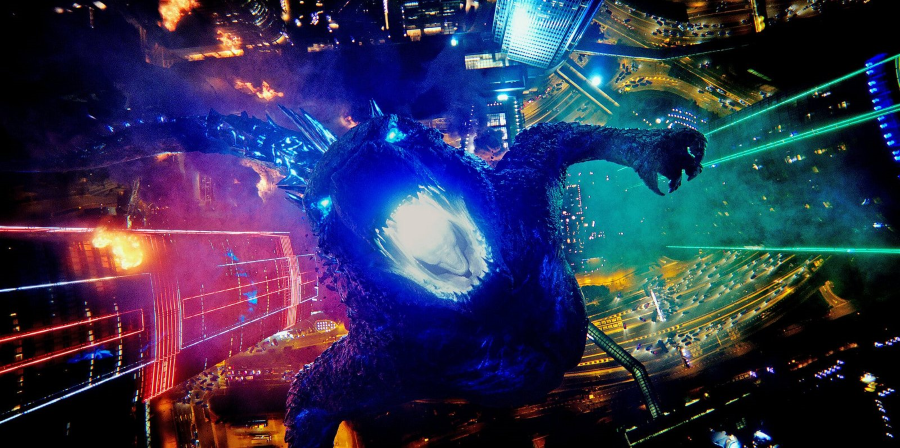
It’s tempting to just view this as a completely standalone film but we can’t. It takes place within the continuity of the MonsterVerse. It has returning characters. It addresses PAST characters. One of its central concepts revolves around a Ghidorah skull. If you didn’t see GODZILLA: KING OF THE MONSTERS, you’re gonna be a little bit lost here. The previous film felt like the finale of something large. Here, it’s just reduced to a prelude to something quite small. The main attraction is watching Godzilla and Kong beat the high holy shit out of each other. The film delivers that and then some. But if the human characters were the Achilles’ heel of the previous installments, the characters in GODZILLA VS KONG are the arrow jutting out of it.
We have two separate groups of human characters. The first group consists of a discredited Hollow Earth physicist named Nathan whose brother died trying to cross the gravitational vortex between the above world and the world below. He’s approached by Walter Simmons, the uber-wealthy head of a cybertech research company called Apex. Simmons wants Nathan to help pilot a fleet of specially designed aircraft into the Hollow Earth for reasons that are probably not nefarious. Nathan contacts his ex-colleague at Monarch, Kong specialist Ilene Andrews and offers her a proposition.
Kong has been kept in a Monarch research facility ever since a storm destroyed Skull Island, killing all of its inhabitants except for one young deaf child named Jia. But Kong is well aware that this is not his home and is growing more and more frustrated with his captivity. So why not take Kong back to the Hollow Earth, the place where the titans once lived? For some reason, she agrees to this incredibly dangerous plan, which entails transporting Kong by ship to Antarctica, a plot strand that only exists so we can once again see a chained Kong on a sea vessel.
Meanwhile, Godzilla has been uncharacteristically aggressive lately, destroying an Apex facility in Florida. This grabs the attention of a conspiracy podcaster named Bernie. He has been working at that Apex facility gathering information (while bathing in bleach and avoiding tap water because he’s nuts). He spots some odd-looking machinery just before Godzilla blows the place up. Bernie has a fan. It’s Maddie, one of two returning characters from GODZILLA: KING OF THE MONSTERS. Believing Godzilla is being provoked into aggression by Apex, Maddie and her friend Josh team up with Bernie to do some light espionage.
Team Godzilla sneaks into the ruined Apex facility. Narrowly avoiding capture by the only two security guards in the entire place, they duck into a transport vessel carrying skullcrawler eggs. Before they can leave, the doors close, and Team Godzilla is whisked away to the main Apex center in Hong Kong.
Meanwhile with Team Kong… As we’re told from the beginning, Kong escaped both Ghidorah’s influence and Godzilla’s attention by being placed in captivity. Now that Kong is out in the open, Godzilla shows up and nearly drowns the poor ape. This happens at the forty-minute mark. We won’t be seeing these two together for quite some time. With the ship crippled, the team decides to airlift Kong to Antarctica (using helicopters and a net, unfortunately; not balloons like in the 1963 original). Once there, Kong goes charging into the Hollow Earth and we give chase.
MEEEEEEANWHILE, Maddie, Bernie, and Josh discover Apex has designed a big metal monster of their own, piloted by a man named Ren using a neural uplink device, a la PACIFIC RIM. This MechaGodzilla is tethered to that previously mentioned Ghidorah skull. There’s talk of Ghidorah’s ‘genetic memory’ in the bones. I’m sure that won’t lead to anything unfortunate.
At this point, Godzilla shows up in Hong Kong, drawn to the area by the presence of Ghidorah’s skull and the massive metal beast in the basement. Kong accidentally triggers one of the ancient radioactive energy sources in the Hollow Earth with an ax made from a Godzilla spine (yes, we learn that these two species were ancient rivals because everyone but Mothra struggled to make friends back then). This causes Godzilla to have a freakout. He shoots his atomic breath down through the Earth, eventually destroying what remains of Kong’s ancestral home. As you can imagine, this doesn’t sit well with Kong. He grabs his ax and up (down?) he goes through the Hollow Earth tunnel.
The final 20 minutes or so of this movie details Godzilla and Kong duking it out before Ghidorah’s genetic memory takes control of MechaGodzilla and all hell breaks loose. Wingard was adamant that his film would end with a single victor. It’s an urban legend that there were two cuts of the original KING KONG VS GODZILLA, one for Japanese audiences and one for American audiences. That never happened. That film ends with a clear winner. This one just kinda ends.
So let’s be blunt. The absolute worst thing about this film is the humans, in particular Team Godzilla. Bernie’s sole character trait is that he doesn’t shut up. This character talks constantly about nothing important. He just… keeps… talking. He’s the comic relief in a movie that doesn’t need any. He’s given a dead wife because that counts as character, I suppose. But what comes out of that dead wife angle? Absolutely nothing except a reason for a neurotic, paranoid character to have a flask of whiskey on him because being neurotic and paranoid isn’t reason enough. I kept being reminded of the OTHER MonsterVerse character who was a conspiracy nut with a dead wife, Bryan Cranston’s Joe Brody in GODZILLA 2014. There, Joe’s dead wife was the result of the monsters whose existence was in fact part of a conspiracy. His obsessive hunt for the truth was driven by a need for closure. Here? Well, we just needed Bernie to have a flask of whiskey so someone can pour it into a security control console.
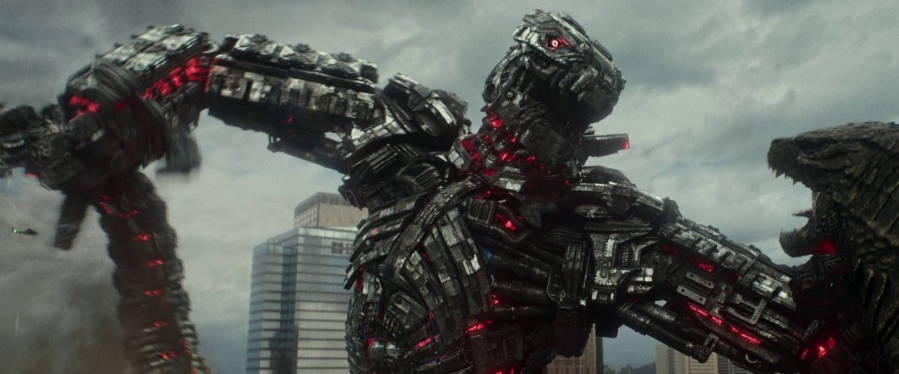
Team Godzilla sneaks into an Apex facility with zero problems. They stand out in the open inside the MechaGodzilla test chamber that is lined with cameras and no one notices them. Upon illegally entering this chamber inside a heavily manned research facility, Bernie screams for no reason except to make a joke. Team Godzilla is finally caught when they leave their perfectly well-hidden surroundings to stand in front of a GLASS DOOR right outside a room full of men with guns. Simply put, Team Godzilla did not need to be in this movie. They do not impact the narrative at all. Their inclusion does nothing but make the filmmakers look stupid.
Team Kong on the other hand fairs better. Make no mistake, this is a Kong movie that Godzilla just so happens to be in. As a result, we spend a lot of time with Nathan, Ilene, and Jia. If I have to say one great thing about Team Kong, it’s that Wingard and Co. did not feel the need to shoehorn in some kind of sappy, pointless love story. They’re not exes, they’re not romantically interested in each other, they’re just two people with jobs to do. Nathan’s dead brother is a bit like Bernie’s dead wife. Utterly irrelevant, but there so you can feel some kind of sympathy for characters with 1/4th of a personality.
Out of the three characters on Team Kong, only Jia stands out. Kong has always been linked to humanity far more than any other monster put on screen (not counting the Universal monsters anyway). From his obsession with pretty blondes to his interactions with the tribal natives that worship him, Kong’s proximity to humans has always made him stand out. The Kong of KONG: SKULL ISLAND, the lonely primate leading a solitary existence, has grown into the adult Kong of GODZILLA VS KONG. He’s still the same lost individual, well aware that he’s the last of his kind. There’s a moment where Kong thinks he might discover relatives living in the Hollow Earth. It’s a testament to the motion capture and special effects team that his discovery to the contrary is actually quite moving.
Kong’s relationship with Jia is what roots him to humanity. It’s the family he needs, even if it’s not the family he seems to want. I will admit, it does feel kind of odd to be talking about Kong like this, but Legendary really did do the character justice, giving us a fully formed thinking creature we can project human emotions onto without committing a fallacy. We didn’t need the Orca to “talk to” Kong. He’s far more human than any other creature in the MonsterVerse, a big softy who treats an orphaned child as family.
Any notion that Kong would be an underdog in a fight with a massive radioactive lizard who can shoot nuclear energy from his mouth goes right out the window as soon as the Hong Kong fight begins. It’s a frickin’ marvel of ingenuity, using the tall buildings as a literal concrete jungle for Kong to leap around. And even though these monsters feel almost weightless thanks to the wonky physics the special effects team employed here, every single punch, kick, and swing of an ax feels impactful. It’s a hell of a fight, one that’s worth the admission cost.
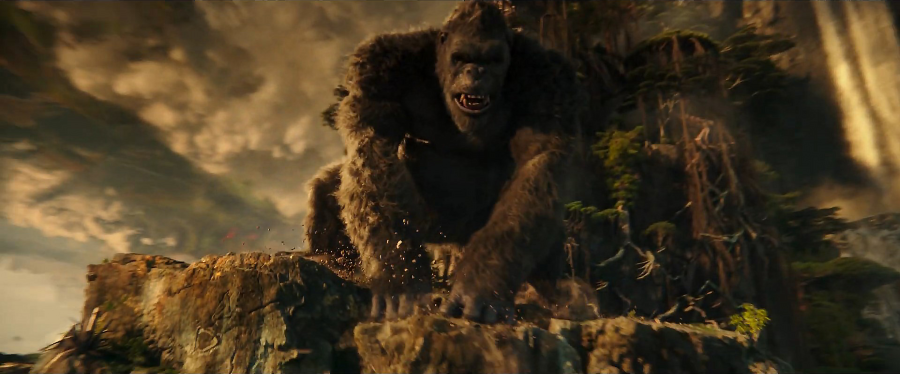
As for this film’s rendition of MechaGodzilla… I couldn’t be happier. I do have some issues with the design but realistically - well, none of this is realistic - it’s not exactly like MechaGodzilla was ever really physically threatening. One of my big hang-ups with Godzilla’s tussles with MechaGodzilla is we are shown over and over again how little use military-grade weaponry is on Godzilla. He just shrugs it all off. But for some reason, whatever tech MechaGodzilla uses works. It’s the whole “why not just build the whole plane out of the black box material?” joke all over again. Why not save money on one MechaGodzilla and spend those bucks on whatever munitions you’re packing into it?
And yes, I know the original MechaGodzilla was an alien creation with alien tech. Trust me, I have ridiculous amounts of knowledge about this stuff. It’s what I have instead of a life.
The MechaGodzilla on display here is lean, fast, and downright menacing, capable of thrust boosting through the air to deliver a great big whack to Godzilla’s throat. At one point, MechaGodzilla repeatedly shoves Godzilla’s face through building after building. I might be a Godzilla fan but damn… At that point in the film, I was having a blast.
But it’s all the other stuff that bothers me. It’s the fact that this is how the MonsterVerse ends, with a standalone film that doesn’t add to or strengthen anything that came before it. It feels like we said goodbye to Godzilla in GODZILLA: KING OF THE MONSTERS, like he was contractually obligated to be here so he’s putting in a few days’ work. This is a finale not to the overall universe but to the story which began in KONG: SKULL ISLAND. If you can internalize that fact, your enjoyment will probably increase.
I just never could. When the credits rolled, I wasn’t angry or anything like that. It’s a movie after all. But I was disappointed, not in the quality of the fights or the outcome of the brawls, but in the fact that this is it. This is the last MonsterVerse film (unless Legendary would like to prove me wrong *wink wink*) and it just doesn’t ever deliver that kind of closure or amazingly finality I hoped it would. A little bit of the energy and grandeur that went into the fights needed to leak out into the story surrounding them. That would have made GODZILLA VS KONG feel like a proper finale.